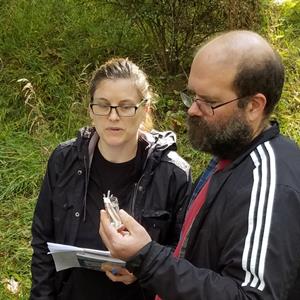By Heather Black, Chesapeake Conservation Corps Volunteer
This morning, I had a thin layer of ice my car windshield. It was a reminder that with each passing day, we are getting closer and closer to winter. The hours of sunlight are shortening each day and temperatures continue to drop. What does this mean for water quality monitoring?
Different programs have different guidelines when it comes to winter stream monitoring. Here at the Izaak Walton League, fall is the end of our biological monitoring season (checking stream health by looking for aquatic macroinvertebrates). Winter is a time when we can regroup and start planning for the coming spring.
But stream stewardship does not stop with the cold weather! There are many ways you can monitor water health and help your community in the coming months:
 Chemical Water Quality Monitoring: This requires much less time than biological monitoring, making the winter months a great time to do it. Chemical monitoring is also important in the winter to check for fluctuations in pH, phosphate, nitrate, and especially chloride (introduced mainly through the application of road salts) and pinpoint problem spots on nearby roadways and stream banks.
Chemical Water Quality Monitoring: This requires much less time than biological monitoring, making the winter months a great time to do it. Chemical monitoring is also important in the winter to check for fluctuations in pH, phosphate, nitrate, and especially chloride (introduced mainly through the application of road salts) and pinpoint problem spots on nearby roadways and stream banks.
Invasive Plant Removal: Late fall and early winter are some of the best times to remove invasive plants. Many invasive species are the last to drop their leaves, making them easy to identify. And as thickets die back, the plants become easier to access and remove. However, you’ll need to tackle this task when the ground is not frozen to permafrost for the winter, since you need to pull up the roots to permanently eradicate these invaders.
.jpg?sfvrsn=1016db0d_2&MaxWidth=300&MaxHeight=&ScaleUp=false&Quality=High&Method=ResizeFitToAreaArguments&Signature=C2EBC103FD70DF610C46B135BBB95E1EC6DF3035) Stream Clean-Ups: Winter might not sound like the ideal time for a stream clean-up, but those willing to brave the weather can be rewarded. As temperatures drop, plants stop growing and lose their leaves, making stream access easier and revealing trash that might have been covered up.
Stream Clean-Ups: Winter might not sound like the ideal time for a stream clean-up, but those willing to brave the weather can be rewarded. As temperatures drop, plants stop growing and lose their leaves, making stream access easier and revealing trash that might have been covered up.
De-icing Responsibly: An easy way to improve local streams is to reduce – better yet, to eliminate – use of road salts for snow and ice removal. Each year, thousands of pounds of these salts get washed into streams and rivers, increasing chloride levels and damaging overall stream health. (Read more about the impact of road salts on stream health.)
Winter Salt Watch: Road salt is everywhere during winter months. It keeps us safe on roads and sidewalks, but it can also pose a threat to fish and wildlife as well as human health. Fish and bugs that live in freshwater streams can't survive in extra salty water. And many of us (more than 118 million Americans) depend on local streams for drinking water. Water treatment plants are not equipped to filter out the extra salt, so it can end up in your tap water and even corrode your pipes. What can you do? Join the Winter Salt Watch to test and report salt levels in your streams!
Stream Selfie: Not ready to wade into the water? Take a Stream Selfie from the banks and put your stream on the map! You can ID places with litter problems and potential monitoring sites. We can also connect you with conservation-minded folks in your community.
Any of these activities would be a great opportunity to enjoy the outdoors this winter. Come spring, you can start biological stream monitoring knowing that you did your part to improve stream health.
P.S. Winter is also a good time to brush up on your macroinvertebrate ID skills! Download our free Aqua Bugs app to test your knowledge.